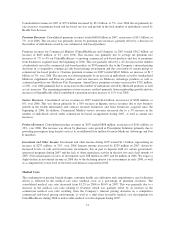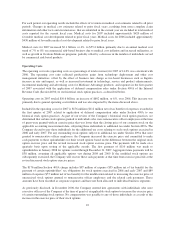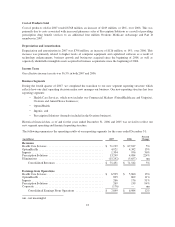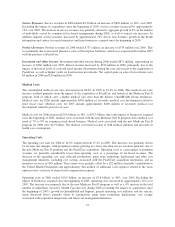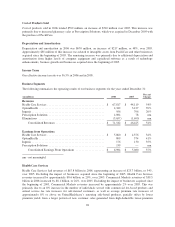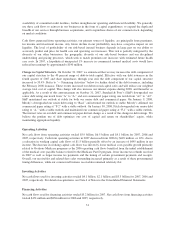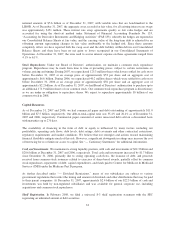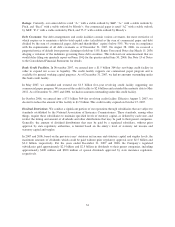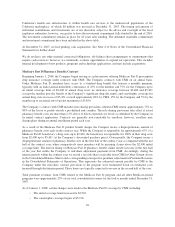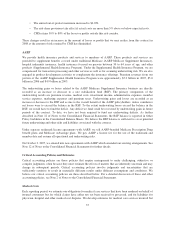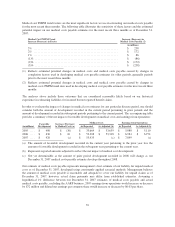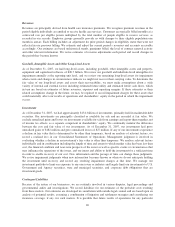United Healthcare 2007 Annual Report Download - page 32
Download and view the complete annual report
Please find page 32 of the 2007 United Healthcare annual report below. You can navigate through the pages in the report by either clicking on the pages listed below, or by using the keyword search tool below to find specific information within the annual report.customer gains. Excluding the impact of businesses acquired since the beginning of 2005, Medicaid enrollment
increased 65,000, or 5%, primarily due to new customer gains.
OptumHealth
OptumHealth revenues of $4.3 billion increased by $1.2 billion, or 39%, over 2005. Excluding the impact of
businesses acquired since the beginning of 2005, revenues increased by 20% over the prior period. This increase
was principally driven by an increase in the number of individuals served by several of its specialty benefit
businesses and rate increases related to these businesses.
Earnings from operations in 2006 of $809 million increased $235 million, or 41%, over 2005. OptumHealth
operating margin was 18.6% in 2006, up from 18.4% in 2005. Realized improvements in operating cost structure
and benefits from the integration of PacifiCare specialty operations in 2006 were partially offset by a business
mix shift toward higher revenue, lower margin products.
Ingenix
Ingenix revenues for 2006 of $956 million increased by $160 million, or 20%, over 2005. This was primarily
driven by new business growth in the health information and contract research businesses, as well as businesses
acquired since the beginning of 2005. Earnings from operations in 2006 were $176 million, up $46 million, or
35%, from 2005. Operating margin was 18.4% in 2006, up from 16.3% in 2005. These increases in earnings from
operations and operating margin were primarily due to growth in the health information and pharmaceutical
services businesses, improving gross margins due to effective cost management, and businesses acquired since
the beginning of 2005.
Prescription Solutions
Results for Prescription Solutions in 2006 included revenues of $4.1 billion, earnings from operations of $139
million and operating margin of 3.4%. The 2005 results included $78 million of revenue and no earnings from
operations. The increases in 2006 were primarily due to the timing of the acquisition of this business, which was
acquired in December 2005 with the purchase of PacifiCare.
Liquidity, Financial Condition and Capital Resources
Liquidity and Financial Condition
We manage our cash, investments and capital structure so we are able to meet the short and long-term obligations
of our business while maintaining strong financial flexibility and liquidity. We forecast, analyze and monitor our
cash flows to enable prudent investment management and financing within the confines of our financial strategy.
Our regulated subsidiaries generate significant cash flows from operations. A majority of the assets held by our
regulated subsidiaries are in the form of cash, cash equivalents and investments. After considering expected cash
flows from operating activities, we generally invest cash of regulated subsidiaries that exceed our short-term
obligations in longer term, investment-grade, marketable debt securities to improve our overall investment return.
Factors we consider in making these investment decisions include our Board of Directors’ approved investment
policy, regulatory limitations, return objectives, tax implications, risk tolerance and maturity dates. Our long-
term investments are also available for sale to meet short-term liquidity and other needs. Cash in excess of the
capital needs of our regulated entities is paid to their non-regulated parent companies, typically in the form of
dividends, for general corporate use, when and as permitted by applicable regulations.
Our non-regulated businesses also generate significant cash from operations for general corporate use. Cash
flows generated by these entities, combined with the issuance of commercial paper, long-term debt and the
30



